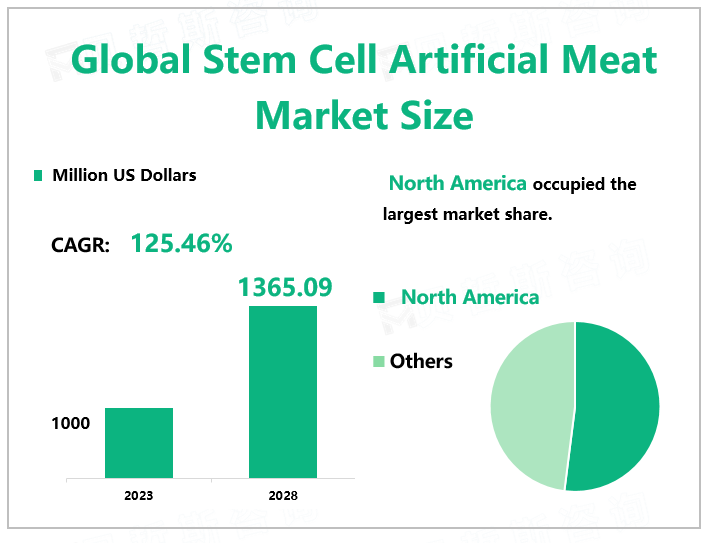Global Stem Cell Artificial Meat Market Overview
According to Global Market Monitor, the global stem cell artificial meat market size is expected to grow to $1365.09 million by 2028 with a CAGR of 125.46% from 2023 to 2028. North America dominated the market with a market share of 47.68% in 2023.
Stem cell artificial meat was developed in the laboratory by Mark Post, a professor of biology at Maastricht University in the Netherlands. He hopes to produce beef through this method of in vitro cultivation of animals to meet human demand for meat and solve environmental problems caused by traditional aquaculture. Stem cell artificial meat is produced by cultivating cells in vitro, so its safety can be guaranteed. The taste of artificial beef is not as good as natural beef.
Market Drivers
To increase profits, many livestock farms feed large amounts of growth hormones and antibiotics to their livestock, which brings hidden dangers to consumers' health. But this kind of stem cell artificial meat is produced by cultivating cells outside of animals to make them multiply and differentiate, so it is similar to natural beef. At the same time, during the cultivation process, absolute cleanliness can be guaranteed, fundamentally preventing viral infections such as mad cow disease and foot-and-mouth disease. And people can also add ingredients that are beneficial to human health in stem cell artificial meat. For example, most meat contains too many Omega6 fatty acids, and eating too much can cause health problems, but stem cell artificial meat can be replaced with non-harmful Omega3 fatty acids. This has promoted the development of the market to a certain extent.

Market Trends
Meanwhile, there are no mature conditions for large-scale production of stem cell artificial meat. Culturing cells in vitro must be able to maintain and simulate a good environment and material metabolism process for cell survival in the body. For this reason, necessary nutrients, suitable pH, strict sterile conditions, osmotic pressure, culture vessels, temperature, and carbon dioxide must be provided. And the limited value-added ability of muscle cells itself makes the cost of producing beef very high. The production cost per kilogram of "stem cell artificial meat" is equivalent to more than 1,000 times the price of ordinary meat on the market. This limits the development of the market to a certain extent. Many people think that the currently developed bovine stem cell artificial meat is not as good as natural beef. The growth of natural beef muscle cells has a systemic organization, including nerves, blood, and even the movement of beef cattle. These are not available to cells cultivated in vitro. Cell metabolism and self-repair functions will be affected and the taste is certainly not as good as natural beef This also limits the development of the market to a certain extent.
|
Drivers |
The safety of stem cell artificial meat |
|
Stem cell in the artificial meat industry has broad prospects. |
|
|
Development of stem cell artificial meat technology |
|
|
Challenges |
High cost |
|
A matter of taste |
We provide more professional and intelligent market reports to complement your business decisions.